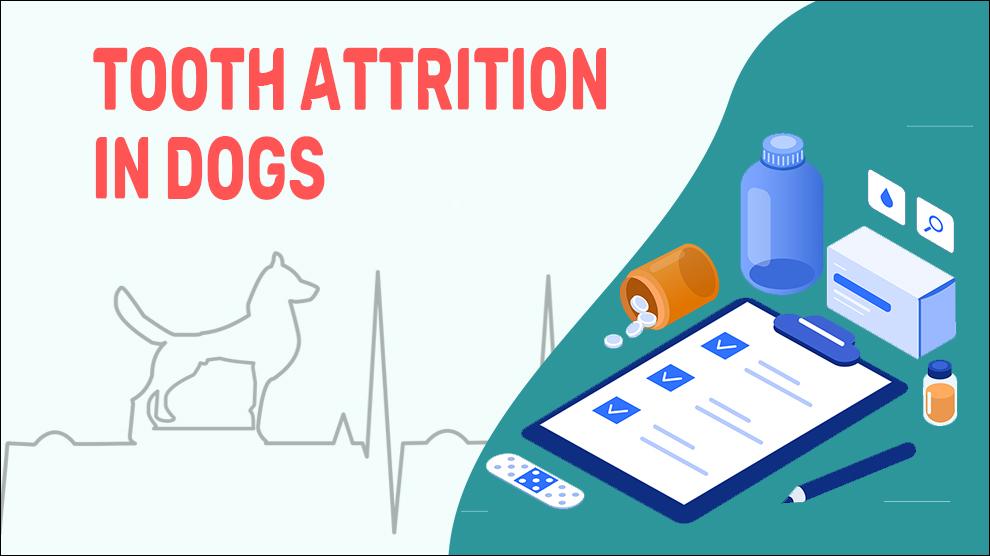What Is Tooth Attrition In Dogs?
Tooth attrition is one of the most common dental conditions in dogs. Physical wear of teeth caused by orthodontic malocclusion (tooth-to-tooth contact), heavy chewing, and biting is called pathologic attrition. By the time they are three years old, almost 3/4th of dogs have some sort of dental problem. Though attrition affects all of the dog's teeth, the most commonly affected are the incisors, as they are involved in the biting process.
Dogs are typically so hard on their teeth and it should be a no-brainer that over the course of their life, their teeth will undergo wear and tear. Sometimes, however, a certain amount of wear is quite normal but there are times when the wear can be too much, leading to unusual losses to the top layer of your dog's teeth. When your dog's teeth start to wear down, the pulp or root can become exposed. The dog's teeth have a natural protective mechanism to this situation wherein the root of the tooth is enclosed by a defensive layer known as dentin.
Reparative dentin resembles a tan- to brown spot in the center of the affected tooth. This second layer of the tooth is developed by cells within the topmost layer of the pulp known as odontoblasts. While rapid wear of teeth does not have a chance to refurbish themselves. These worn-out teeth may have bare pulp canals that may cause pain and infection.
When your dog is suffering from attrition, Chances are good that you will be able to see it in the type of worn teeth that looks to be lower than nearby healthy teeth. Moreover, when the attrition has reached the level at which the nerve is exposed, your pet will experience pain.
Symptoms Of Tooth Attrition In Dogs
- Tooth discoloration.
- Changes in tooth shape
- Loss of tooth structure
- Red or swollen gums
- Bad breath (halitosis)
- Difficulty or pain with chewing
- Pus/mucous along the gum line, in nasal discharge
- Tooth pain
Treatment Options For Tooth Attrition In Dogs
- Dental cleaning procedures such as dental sealants
- Dental scaling - Ultrasonic cleaning equipment/ conventional hand scalers to clean off the plaque and tartar
- Gingival curettage - Removal of gingival crevicular epithelium from the gingival sulcus at the gingival margin around a tooth
- Gum infections - Application of antibiotic medications
- Gingivectomy - Removal of excessive gingival tissues
- Gingivoplasty – Reshape the gums' appearance by the removal of diseased soft tissue from the wall of a periodontal pocket
Home Remedies For Tooth Attrition In Dogs
- Dental wipes: Vet’s Finger Wipes, Plaque Toothwipes (Petkin), Dental Cleansing Wipes (Maxi-Guard), Dog Dental Wipes (Pet MD), etc
- Chew toys for dogs; Goughnuts Medium (small dogs), West Paw Hurley – (tiny dogs), Goughnuts MaXX (large chewers), Kong Extreme, etc
- Oral rinses such as CHLORHEXIDINE ORAL RINSE, TropiClean Fresh Breath Advanced Whitening Dental Health Solution, Fresh Breath Dental Health Solution, etc
How To Prevent Tooth Attrition In Dogs?
- Prevention of wear and tear is the simplest way of preventing attrition.
- Chew toys, oral rinse, or dental wipes may also help decrease or delay attrition.
- Pet-safe enzymatic toothpaste or veterinary oral health council-approved dog toothpaste that is specially formulated for dogs at least a few times a month.
- Provide exclusively formulated dental diets for dogs.
Affected Dog Breeds Of Tooth Attrition
Poodle, Yorkshire Terrier, Chihuahua, Brachycephalic Dog Breeds.
There is no breed disposition.
Causes And Prognosis For Tooth Attrition In Dogs
1. Causes:
- Bruxism- clenching and grinding of teeth during sleep
- Orthodontic malocclusion (tooth-to-tooth contact)
- Heavy chewing
- Biting
2. Mortality:
There is no mortality associated with tooth attrition documented yet.
3. Diagnosis:
- Routine dental exam
- Dental X-rays
4. Prognosis:
Starting stage dental attrition prognosis is good provided that they receive the proper dental care. Moreover, the prognosis for the advanced stage is also good if the latest dental procedures are performed. The prognosis is poor only when more than half of the tooth and support structures are lost.
When To See A Vet For Tooth Attrition In Dogs?
Time to visit the vet clinic for an examination, if you notice any of the following:
- Tooth discoloration.
- Changes in tooth shape
- Loss of tooth structure
- Red or swollen gums
- Bad breath (halitosis)
Food Suggestions For Tooth Attrition In Dogs
Best foods for your dog teeth:
- Green Leafy vegetables: Beet greens, cabbage, Spinach, Broccoli, Green Beans, cauliflower, etc
- Foods with fluoride: Spinach, cucumbers, chicken by-product meal, beef and bone meal
- Calcium: Plain yogurt, Cheese, milk, and legumes such as broccoli, spinach
- Cooked chicken giblets (liver, gizzards, hearts) and Bones (raw, not cooked)
- Essential fatty acids (salmon, whitefish, mackerel, cod, tuna, herring, sardines, trout, etc)
Foods to avoid:
- Rice or potato-based dental sticks
- Kibbles containing a higher percentage of refined carbohydrates
- Chocolate, Gum, and candy
- Dry dog foods
- Treats with fillers, Crackers, Popcorn
Conclusion
The prevention of tooth attrition should be given top priority because it can lead to other dental health problems such as gingivitis and subsequently periodontal disease. When the oral health of the dog is affected, it can cause other systemic problems. So it is good to set up a regular dental cleaning routine for your dog.

















